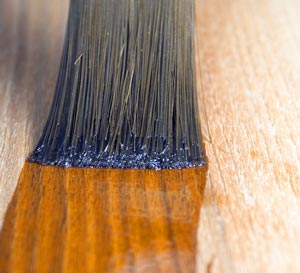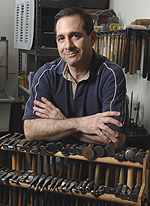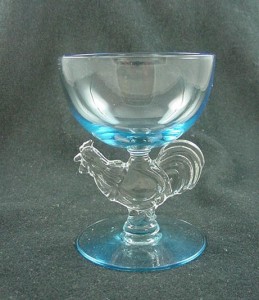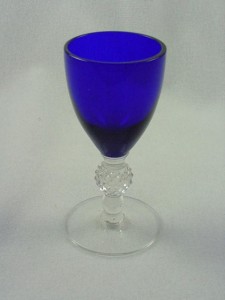Contributed by www.Marks4Antiques.com – a membership-based service specializing in providing identification & appraisal advice on antiques & collectibles.
NOTE 1: Any form of cleaning or restoration of antique metal objects may necessitate the use of various chemicals, many of which are poisonous. Even if by themselves they are not, sometimes combinations of them can produce fumes that are harmful and occasionally lethal. Therefore, it cannot be emphasized too strongly that no cleaning should take place in a confined area or in close proximity to food. All of the methods described below should be performed very carefully and with every safeguard that can be made available.
NOTE 2: Not all antique Metalware items should be cleaned and no general diagnosis can be applied. Each individual object must be subjected to individual attention. Obviously what is suitable for a pair of antique brass candlesticks of the 19th century, for example, is not applicable to a considerably earlier object such as a Sheffield silverplated tray. Also, the use to which an item will be put is an important consideration; for example, is your Georgian antique Coffee or Tea Set or your pair of collectible candlesticks going to be used or are they purely for display or to be kept as cabinet pieces? If used for food or drink still more difficulties will arise. All items should be handled with extreme care until you have discovered your own abilities and the techniques that you can manage. In early stages of experimentation in cleaning and polishing you should practice on articles of no great value and, broadly speaking, the more antique an item is the less you should clean it or even handle it.
The information in this article is of a general nature: if you have a piece of antique metalwork that you value a great deal or that is of such merit that it needs extra careful handling, the advice of a museum or of a specialist expert should be sought. There are so many different blends of base metals used on antique metal ware that the cleaning methods applicable to some will do more harm than good to others. There are also certain individual pieces of metalwork, which, because of their very nature, require specialist treatment. At all times it should be aware that in cleaning an antique metal ware item, your aim should be to clean and restore an object as near as possible to its original condition.
There are, however some exceptions to this rule: one is the case of an object of some age which has acquired a permanent and pleasing patina, an antique or collectible Lamp, for example, or a medieval candlestick or bowl, which has become dark green, brown or black with age. If there is no deterioration of the metal, then this patination should under no circumstances be disturbed. A sparing application of a good quality transparent wax polish carefully removed with a silk cloth should not do any damage to a patinated object and will improve the surface.
Another example of an antique which does not benefit from the attempt to restore it to its original state is a piece of old Sheffield plate which shows signs of wear. The color of the metal showing through the silver – this is known technically as ‘bleeding’ – is to some collectors a point in its character. In any case, replating by modern electroplating will never give back the original color. The charm of antique Sheffield plate lies in the mellow color of the old silver, nowhere near as white as modern electroplating. In its own lifetime, if there were a fault or if, through heavy usage, Sheffield plate had to be repaired, this was done by French Plating. This method of restoring antique Sheffield plate uses a very fine silver foil that was laid over the worn part and made to adhere by a little gentle heat or by burnishing. French Plating is rarely used by craftsmen nowadays. Only when a piece of antique Sheffield plate has completely lost all its original plating and is reduced to an entirely copper appearance is it perhaps permissible to electroplate and then merely in order to restore it to something like its original state, especially if it were used for food.
In general, the first step in the care and conservation of an antique piece of metalwork is the removal as far as possible of whatever is causing deterioration, such as rust in the case of iron and steel, then thorough cleaning and polishing followed finally by the application of waxes or lacquers to help to delay decay.
It is impossible to arrest decay on antiques completely: all one can do is to delay it for as long as possible. As in any other form of antique a moderate even temperature is required, and it is necessary to avoid extreme cold or damp. These are in effect the main essentials of what is known in an antiques museum as ‘conservation’. What techniques and practices you use and how you tackle the work depends largely on whether the metal is brass, steel or pewter and of course the composition of the actual item.
Antique Iron and Steel
With antique iron or steel objects, which are frequently found in a rusty state, the first step must be to remove this rust. Any that is loose may be removed with a wire brush and then, if the object is fairly small, boiling in caustic soda will remove a great deal of what remains. CAUTION: Do not let this mixture come in contact with your hands or your eyes. If an accident should occur, wash any skin surface that has been exposed lots and lots of clean fresh water.
For a larger object it is necessary to soften the remaining rust by soaking the item for several hours in paraffin oil or in one of the commercial derusting oils. However, most chemical derusters tend to leave a dull matt-grey surface, which the original antique piece rarely had. They are excellent, however, for treating antiques which are going to be painted a dull black such as wrought iron lamps or railings.
Another general method is to use a fine grade of emery cloth and oil. The emery cloth may be wrapped round a shaped stick for getting into the various contours of a pattern. The oil will help to prevent too many scratches. If you use emery paper dry you will get a very scratched surface indeed. Use the mildest emery that will do the job, and when you think you are near to finishing, cut it to a yet finer one. Coarse emery should not be used except in very bad circumstances. Never clean too heavily upon a raised surface as you will tend to blunt the pattern.
Having cleaned the item to the degree you want, wash with methylated spirits, dry with clean cloth and place it, wrapped in a piece of newspaper, in some form of heated cupboard (an airing cupboard is ideal) and leave it there for two to three days to drive out any damp that may be in the metal. If you are not going to put it to practical use, at this stage seal with lacquer or wipe over with an oily rag. Some antiques collectors wax polish their ironwork: if your house is very dry this is quite a good finish. The great enemy of iron and steel is of course damp, and this will cause rust very rapidly. As in almost every other form of antique metalwork, a dry atmosphere is the most beneficial. If the atmosphere is damp and there are chemical impurities or salt in the air, you should periodically wipe the piece over with a slightly oily rag. From time to time, inspect antique iron or steel specimens for signs of rust.
Antique Wrought Ironwork
Some specimens of antique wrought ironwork may be rather large, as for example gates or window grills. Remove as much loose rust as possible with a wire brush, clean off with emery paper, seal with a derusting fluid and finally paint with a dull black paint. For a really fine piece of antique wrought iron, the treatment should be left to an expert.
Antique Cast Iron
In the case of antique cast iron objects, usually of the 19th century and which are now very collectible, there are two treatments. They can be either cleaned of all loose rust, dried and painted black, a very good treatment for any form of antique iron item, or they can be sand-blasted by a professional. This gives a sort of silvery effect. The object should then be lacquered.
Georgian or Victorian Cut-Steel
The cleaning of an antique piece in cut-steel must be approached with great care, and if possible each little facet should be cleaned separately. Please use extra care and be patient because it is important that the edges of cut-steel do not get dull. This applies to all examples of cut-steel from large objects such as Georgian andirons to small pieces such as a buckle, an antique buttonhook or a collectible corkscrew. The great glory of cut-steel is its many facetted surfaces, and these should be kept as crisp as possible.
Antique Brass and Copper
The age-old method of half a lemon and salt is excellent especially for a flat surface such as an antique tray. Apply, rinse off, dry carefully and clean with an impregnated wadding, polishing finally with a soft cloth. A piece of old silk is ideal; manmade fibers such as nylon tend to scratch the surface. Sometimes with deeply engraved or repousse decorated antiques, extensive cleaning in the past may have clogged the pattern with the remains of old dry polishes. This should be removed with a little methylated spirit and a stiff brush and then cleaned with impregnated wadding as described above. This wadding is less likely to leave traces of cleaning material behind.
Another method for an antique brass article is to wash it in a mild ammonia solution and then to clean with either oxalic acid and salt or vinegar and salt. Following this treatment, it should be washed with water, polished and lastly lacquered.
To save cleaning, and consequently to preserve antique metal ware, a modern technique much used by museums is to lacquer with a cellulose lacquer specially made for brass or copper. This should most certainly be carried out with any early or rare pieces and for pieces with fine crisp edges. The item should first be thoroughly cleaned, either as above and finished off with a succession of cloths until none is soiled, then cleaned with acetone. This should not be done in a confined space or near a flame because this liquid is very volatile. Cotton gloves should be worn to avoid fingerprints which would show under lacquer. Note: rubber gloves should not be worn as some types are destroyed by acetone. When cleaned, the piece should be lacquered with a good cellulose lacquer painted on slowly and liberally with slow easy strokes and avoiding bubbles. Do not worry too much about brushmarks since these usually disappear in the drying. If the piece has been previously varnished or lacquered, this can be removed with paint stripper, following the manufacturer’s directions, then treated as above. If the object is not handled too much, this type of lacquer will last for some years.
Antique Bronze
Antique bronze pieces, either in the form of a figurine or a really antique goblet or lamp, have normally over the years acquired an all-over patination, ranging through many shades of brown to green. If this patination is breaking up and there are spots of a brighter color, as for example bright green, action should immediately be taken to stop this because this efflorescence is the change in the surface of the metal which is known as ‘bronze disease’. It is extremely difficult for the amateur to treat and a museum or a specialist antiques restorer should be consulted at once.
As a temporary measure, if it is quite definitely active and the collector is unable to get professional help quickly, the light powder should be brushed off and the piece kept as dry as possible. To clean a normal bronze, wash it with a very mild soapy solution, dry thoroughly and then apply a little fine wax polish.
Antique Ormolu
Ormolu was frequently used for antique candelabra, antique candlesticks, on handles of andirons, antique desks and other antique furniture and small ornamental pieces in general. The gilt was applied in various ways, but with some forms of inferior ormolu, it was only a thin layer of gold lacquer painted over finely finished and polished brass. This method was frequently used by English craftsmen copying the French. Cleaning should be tackled with great care; gold at best is a very soft metal and harsh cleaning will remove it. As a first step in the cleaning of an ormolu antique piece, choose an inconspicuous area and observe the effect of cleaning on this. Use warm water to which has been added a mild solution of household ammonia and a good quality soap-based washing liquid. If no ill effects can be seen, continue with this cleaning for the complete piece. If a stronger cleaning mixture is needed, add more ammonia. Work in a current of air and wear protective gloves.
To clean ormolu mounts on antique furniture, carefully remove each from the piece of furniture, making a note of its original position. Save the pins, nails or screws that were used to fix it. It is a good idea to make sketches of mounts; the fixing pins can then be stuck through the equivalent holes. This is not just good advice: it can be very necessary as antique mounts were individually made and will not always fit into another position. Once removed, they may be dealt with as described above. If ormolu needs regilding, consult a professional Metal Plating Specialist. Modern gilding by electroplating is rather bright and produces a shade different from that of the old antique ormolu. On the other hand, the old technique of mercury-gilding (fire-gilding) is very expensive and gives off poisonous fumes. Very few craftsmen use this method, but for a superb piece it is worth trying to find a firm specializing in it. Never use a gold paint or lacquer because under no circumstances does this give the right appearance.
Antique Pewter
If you collect this interesting metal, your first and immediate problem is whether to clean your pewter bright or to leave it patinated to a dull natural sheen. Some pewter collectors prefer it in a bright state, whereas others like the quiet soft gray color. In most cases, antique pewter, if in reasonable condition, should be left as far as possible undisturbed.
If the metal has deteriorated through neglect or by being exposed to extremes of heat and cold, and obviously needs attention, it should be conserved with extreme care. Any dent or damage of that nature should be dealt with by an expert.
On the subject of cleaning antique pewter there has been an amazing variety of methods advocated over the centuries. A few of the standard cleaning techniques are based on methods used as early as the 17th century. During the period that pewter was in common use for food and drink, it was kept bright by a very mild abrasive, such as crushed eggshell, fine sand etc., was washed in soapy water, rinsed in clean water and dried. Then, if not being used at once, wiped over with an oily rag. If pewter purchased today is bright and clean and the intention is to keep it that way, clean the piece with impregnated wadding, polish with a clean cloth and olive oil or a similar oil.
If pewter is not kept polished, it gradually dulls down over the years, by a process of oxidation, to a soft gray sheen, much admired by many collectors of antiques. This patination is certainly attractive and to preserve it, the piece should be kept very slightly oiled all over with olive oil. Oil of any description seems to revive antique pewter by penetrating into the metal.
Unfortunately, due to the nature of pewter, its susceptibility to extremes of heat and cold and the consequent corrosion that can develop, this attractive metal is often purchased with bad oxidation or patches of what is known as pewter disease. This must be treated or the piece will be ruined. Great care must be exercised in this treatment both for the metal and also the person handling it, as the materials used are often poisonous or harmful to the skin.
If there is heavy corrosion (or pewter disease) one of the following methods may be of some use.
1. Add one pound of caustic soda slowly to four gallons of cold water, using an iron container. Heat the mixture slowly. Place some hessian or canvas in the bottom of the container and lay the pewter piece on it. Keep the mixture boiling for some hours, examining at intervals. If this shifts the corrosion, remove from the mixture, rinse thoroughly in warm water and clean with a fine abrasive such as crocus powder, rotten-stone or very fine emery powder and paraffin, finishing with powdered chalk or plate-powder. Lastly, oil the piece.
2. Another method, for perhaps a less corroded piece, is to wash in a strong mixture of soap and soda, then cover the whole surface with a watered-down solution of hydrochloric acid applied with a rag on a stick. The strength should be 60% water and 40% hydrochloric acid. (Warning: always add the acid to the water, never the water to the acid.) Leave on for a short while, then rinse off. Reclean with fine emery powder and oil. Wash, first in soapy then in clear water, and polish.
3. Another recipe for cleaning is: 2oz caustic soda, 2 oz lime, 6 oz common salt. Dissolve this in three quarts of warm water. When dissolved, add the mixture to two gallons of cold water. Leave the piece of pewter in this solution to soak and finally clean with fine emery powder and oil.
Also useful as a cleaning agent is oxalic acid, either used neat or watered down. Rub in with fine emery powder, rinse off and polish, then oil.
After using any of these methods of cleaning, a prolonged soaking in paraffin oil for several days will do no harm and should revive the metal.
For general cleaning, if this is necessary, the safest method is to use very fine abrasive powders such as rotten-stone or crocus powder or a very fine emery powder. Put on with an oily rag and work in a circular motion to avoid obvious signs of scratching. Grades of ‘fine’ emery paper, liberally drenched in oil, may be used for cleaning but must be used with care. Always use the finest grades and again rub in a circular motion to try and avoid scratches that show. The piece can be finally cleaned with a little white spirit or methylated spirit, dried and then oiled.
All antique pewter will remain in good condition if kept behind glass. When properly cleaned it can remain in a good display cabinet for at least a year, and this of course is the best way of preserving it. A good display of cleaned antique pewter may be seen in the American Museum in Great Britain. Pewter should never be stored in an oak display case or on oak display racks as this wood contains acid fluid, which reacts against any metal of the pewter-spelter-lead group. An open oak dresser, against which it is often seen, is less dangerous to the metal as the collector would polish both dresser and metal fairly frequently and so prevent corrosion.
Antique Lead and Zinc (Spelter)
The above remarks also apply in the main to lead. Objects in this metal that you may come across are antique tobacco-jars or small lead figurines. Zinc is also known as Spelter. Antique Zinc objects of the 19th century are frequently found and are often in a very dirty and distressed condition. It is possible that a stiff wire brush and a little oil will get these articles up to quite a high degree of polish. Wash the pieces in hot soapy water using a stiff brush; on no account use caustic or any soda. Clean with a wire brush and oil, and polish with an impregnated wadding. Finally clean with acetone or methylated spirits and, if you wish, lacquer. If you prefer not to lacquer them, some 19th-century antique pieces can be cleaned once a week with impregnated wadding without doing much harm.
Antique Tole, Pontypool, Barge Ware and Japanned Tin
Extreme care must be taken to preserve and not destroy the existing paintwork. You might find it useful to try a mixture of one-third white spirits, one-third methylated spirits and one-third linseed oil. This is a good and fairly harmless cleaning agent for antique paintwork. Apply with a cottonwool pad to a small corner of the object and see what results you get. If you are satisfied that you are not attacking the paintwork, clean the whole surface and apply a little good quality wax polish. If the piece is in definite need of paint restoration, try to find a competent professional antiques restorer who will take the job on. The restoration must never alter the feeling of the original piece and the object should not be entirely repainted. As much as possible, the original antique paintwork should be preserved. Do not attempt to paint it yourself unless you are experienced and competent, and then be careful not to overdo the restoration or the spirit of the original will be lost.
A final note: Please use extreme care when cleaning your antique metalwork, both for your own sake and also for that of the metal collection. Please always bear in mind of the varying compositions of the individual metals and the state of decay in which an individual antique item may be found. Never rush into cleaning a piece. Never hesitate to consult a museum or a specialist on any problem that may arise.
 Over the years, antiques have been passed down from generation to generation, from one antique shop to the next, and from flea markets all over the world to your home. With the volume of households antiques have been in over the last 50-100 years, is it any wonder any of it is still in mint condition?
Over the years, antiques have been passed down from generation to generation, from one antique shop to the next, and from flea markets all over the world to your home. With the volume of households antiques have been in over the last 50-100 years, is it any wonder any of it is still in mint condition?




 collectors generally agree that such a repair is acceptable.
collectors generally agree that such a repair is acceptable.